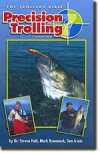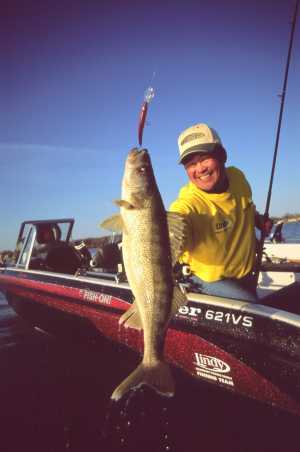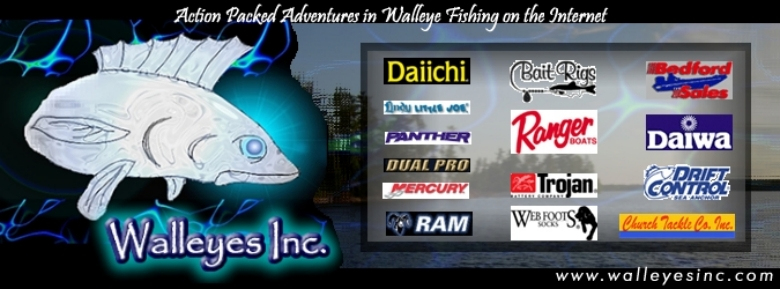|
Walleye fishermen after a trophy can’t snooze in springtime.
The key is to be on one of the Great Lakes early in the year
in time to catch huge females that every angler dreams about.
Listen to walleye pro Jeff Taege while he describes a day
he enjoyed with his father while pre-fishing for a Professional
Walleye Trail event on Lake Erie; “It was two years ago. We
were trolling crankbaits over 30 feet of water. The biting
fish were 12 to 14 feet down. We got into them so thick, we
couldn’t keep four boards in the water. Five or six were over
10.5 pounds, including one that weighed 13.9 pounds. That
was a giant. It was my biggest fish ever.” “We had 40 fish
all over 6.5 pounds that day. It was awesome and totally unbelievable.”
Remember, this is a man who makes his living as a fishing
guide and who competes in major tournaments. He’s seen a lot
of good days on the water. But, the formula of spring plus
the Great Lakes equals an experience to impress even the most
seasoned of anglers. Great Lakes’ patterns early in the year
play right into Taege’s strengths. The Rhinelander, Wisconsin
man is known as a trolling expert. Trolling works best on
the open-water walleyes that spawn on rock reefs in places
like Lake Erie and Lake Michigan. The Great Lakes are expansive,
and trolling allows him to cover more water faster in order
to find the big females scattered off of spawning reefs where
they wait to spawn at night or where they feed on suspended
baitfish, like ciscoes, alewives and smelt, when spawning
is done. “When you’re looking for trophy fish, you want to
cover water fast,” Taege said. “You’re eliminating water and
looking for those areas that hold big fish.” Trolling tactics
also work to intercept big females that spawn in rivers which
empty into the Great Lakes. The key to success on these lakes
is to narrow your search.
Learn the spawning habits of the walleyes, and locate those
areas, principally reefs, on maps. Males will be stacked on
the reefs waiting for females to arrive. The places you’ll
want to focus on are the deeper-water areas nearby where females
stage before moving to the reefs and where they return afterward.
Identify several likely spots. Walleyes are nomads. What you
heard about their location yesterday may not mean a thing
today. Plan to stay mobile. Once on the water, travel to each
place you’ve pinpointed and look for bait fish on your sonar.
Taege won’t wet a line until he sees some action on the screen.
Then, and only then, he’ll put out lines. He starts with 8-foot
telescoping St. Croix rods, which he says are perfect for
rough seas and giant fish. Line counter reels are a must so
you can duplicate success once you determine the action, profile,
color and depth that works.
 Precision Trolling Book 7th edition
now on sale at Walleyes Inc Click
here for more info
Precision Trolling Book 7th edition
now on sale at Walleyes Inc Click
here for more info |
Make sure you have exactly the same amount
of line on each reel so the line counter measurements
are the same from rod to rod. “Precision Trolling” gives
dive curves for common lures based on the use of 10-pound
line. Taege said stick with that diameter of line so the
water resistance is the same as it was during tests for
the book. You might get an estimate on how deep to run
lures if you see large hooks that represent walleyes on
the screen. Still, make sure you run other lures at different
depths, including high in the water column where fish
may be suspended too shallow to appear on your sonar.
His favorite crankbait is the deep-diving Husky Jerk,
especially if walleyes are keying on smelt or alewives.
He likes the emerald shiner pattern or blue chrome or
black chrome in clear water. He switches to firetiger
or clown in stained water. |
 |
Try several and change up often to single out the colors
that are best on any given day. Switch to Shad Raps if
walleyes in the livewell cough up shad. Taege will also
add a nightcrawler to the back treble hook. Start at a
fast pace, 2.2 to 2.5 mph. If that speed doesn’t trigger
bites but your electronics say you’re on fish, slow down
gradually to about 1.8 mph. Make S-turns to vary speeds.
Outer boards are going faster, inner boards are going
slower. Watch to see if walleyes signal a preference.
Take time to enter a waypoint on the GPS every time a
board goes back to signal a bite. You’ll soon have a “picture”
of the size of the school. If the bites stop, Taege travels
beyond the limit of the farthest icons in every direction
until he relocates the school. Don’t overlook the fact
some Great Lakes’ walleyes also spawn in feeder rivers.
They migrate upstream as far as they can in places like
the Fox River, which connects to Lake Michigan. Once stopped
by an obstruction like a dam, they look for shallow hard-bottomed
areas to lay their eggs. Typically, males will be up top
while females hold in adjacent deeper holes during the
day. As with the reefs, some will be feeding after spawning
while others are waiting to move in shallow at night to
reproduce. Taege often trolls three-way rigs in these
rivers. |
If working shallow, he’ll use a small one-quarter ounce
jig on the bottom. More often, he’ll be trying to reach deeper
fish in faster current so he’ll resort to a three or four
ounce bell sinker on a five inch dropper. Sometimes, he uses
even heavier weights in places like the swift Detroit River.
His leader is usually 48 inches long. Where legal, he’ll tie
two lures separated by 18 inches on each rig. He uses shallow
running, floating crankbaits in number 5’s, 7’s and 9’s. Vary
the colors between the two to give walleyes a choice. In stained
water, try orange, firetiger and chartreuse. Stick with natural
colors like blue, black, gold or silver in clear water. Taege
adds reflector tape to the sides to give off more flash. Use
your trolling motor or kicker motor to slide from side to
side, forward and back, with the boat pointed upstream. “That’s
really an effective way to clean out a hole,” he said. Taege
also uses leadcore line to troll deeper graveled areas where
big females move up to feed. He starts with two 10-1/2 foot
St. Croix steelhead rods and two shorter rods of six feet
or less. That allows him to separate lines and avoid tangles.
He uses line counter reels with exactly the same amount of
leadcore to allow precise duplication when he finds the exact
distance which works best. For example, if he may troll in
water 12 feet deep and discover 74 feet of line out connects
with fish. He can quickly set the other rods to the same distance.
He uses a leader of 14-pound braided line, unless the water
is clear then he’ll switch to mono. He chooses Shad Raps for
this technique. Lures on two rods grind the bottom. The other
two are run just off the bottom. Go upstream at the pace of
a slow walk. Some days, walleyes will take the lures when
they are trolled downstream, he said. If so, go faster than
the current in order to make the lures work correctly. Try
the Great Lakes for early season trophies.
|

